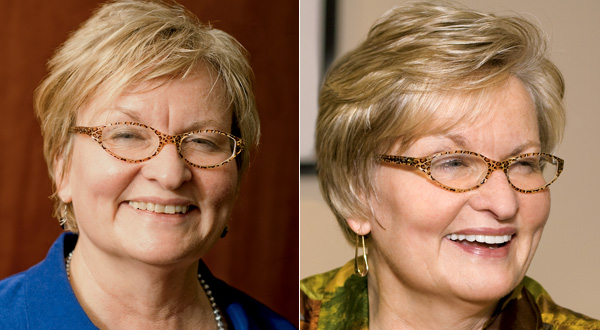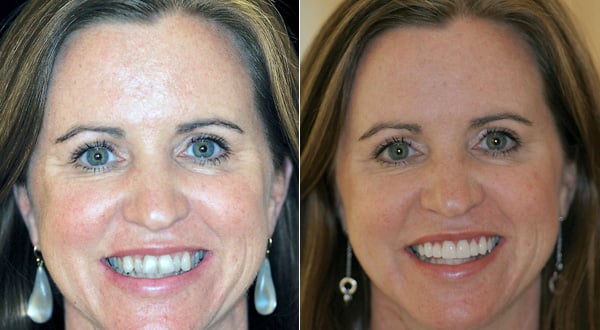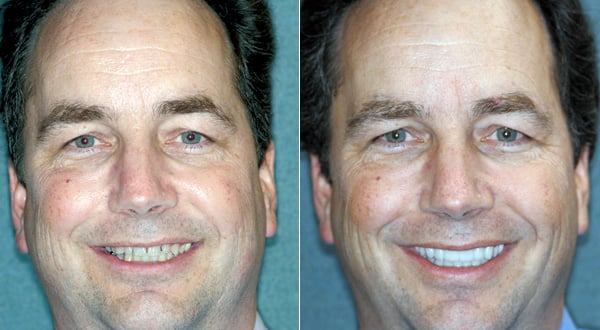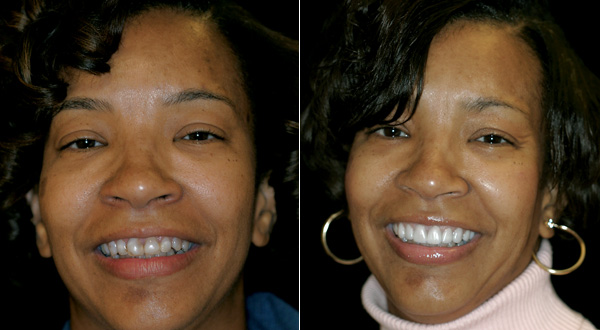
A stale Jujyfruit changed Carlos Carro Duplá’s love life.
The DC computer scientist was at the theater five years ago when he bit into the hard candy and cracked a tooth. The tooth, which had an aged silver filling, had been weak.
On a colleague’s recommendation, Duplá, 42, headed to Dr. Brian Gray’s office in DC’s Tenleytown neighborhood.
“Dr. Gray said, ‘We’re fixing that broken tooth with a porcelain onlay,’ ” Duplá says. “I thought that would be the end of it.”
It was only the beginning. After the onlay was placed atop the tooth—onlays go on like old-fashioned fillings but are more durable than silver and undetectable—Gray suggested a smile makeover. Duplá’s numerous silver fillings had turned black, his bite was off, and his teeth were unevenly shaped and—due to his weakness for coffee and Coca-Cola—were stained.
Gray, whose specialty is cosmetic work, suggested restoring the teeth with a combination of bonding (composite resin directly applied to the tooth); more porcelain onlays as well as porcelain crowns (also called caps, they cover the entire tooth); veneers (fine, translucent porcelain shells that wrap around the front surface of a tooth and won’t stain); bleaching; and Invisalign (invisible, plastic, removable retainers that progressively move teeth into correct alignment).
According to the American Academy of Cosmetic Dentistry (AACD), the numbers of these procedures are growing: There was a 13-percent increase from 2005 to 2006—the most recent figures available—and a projected increase of more than 10 percent in 2007.
The most requested procedure is whitening, which has increased more than 300 percent since 1996.
Although most cosmetic dentistry is not covered by insurance, Duplá says his policy paid for part of the Invisalign. The rest came out of his pocket.
“But it beats having women tell you your teeth look horrible the first time you meet,” Duplá says. “Now dating’s better. Women say my teeth look great—normal, natural, and white.”
How White Is Too White?
What looks natural now is a much whiter white and straighter straight than a decade ago. Celebrities and such TV shows as Extreme Makeover have had something to do with that. Dentists must balance what patients think they want—blinding Hollywood white—with what would look good.
“How white is too white? You don’t want teeth that are refrigerator white. They’re not supposed to hurt people’s eyes,” says Gray, who treats many TV newscasters, some of whom are “bleach addicts” who he says push to go to off-the-chart “Regis white.” Gray says he occasionally caves to those appeals even though, he says, “I want someone to say, ‘Wow, you have a pretty smile,’ not ‘Where did you get your teeth bleached?’ ”
Sandy Spring dentist Linda Steel says that while she always creates natural smiles, patients who appear on TV may need a whiter shade of white. Steel and her husband, dentist Chip Steel, have been the official cosmetic dentists for the Miss Maryland and Miss Maryland Teen beauty pageants since 1998.
“Each year the winners are referred to our office by the pageants, and we optimize their smiles prior to the national competitions,” Steel says. That means bleaching and sometimes Invisalign, bonding, and veneers.
Women tend to be more ultrawhite-obsessed than men, Gray says: “They’ll show me pictures of Angelina Jolie or Jennifer Aniston and say, ‘I want to look like that,’ ” Gray says. “My response is, ‘I can’t make your teeth look like that. I can make them as nice as possible but not artificial.’ ”
Steel agrees that women seem more interested in better smiles: “I see successful men in their forties and fifties who have fine teeth, but they’re not as white as they could be or maybe they have a chip in one tooth. They’ll usually say, ‘My wife sent me here.’ ”

Mary Jane Bilik, 58, a partner at the law firm Sutherland Asbill & Brennan, noticed that the bottom edges of her front teeth were beginning to nick and crack. One tooth, a dentist told her, was weakening. So Bilik decided to brighten her smile—and, in the process, strengthen her bite. DC dentist Dr. Stuart Ross placed eight veneers on her front teeth. “I’m very happy,” Bilik says. “My teeth feel stronger and smoother.”
Photograph by Chris Leaman.

Marti Lazear had had braces as a youth, but as she got older some of her teeth got crooked. One day she went for a consultation at the Washington Center for Dentistry in DC, where Dr. Peter Rinaldi recommended eight veneers. Sold, she had the work done that day. “People said, ‘Did you have your hair done? You look refreshed,’ ” she says. “I think it’s from smiling more.”
Some patients turn to drugstore whitening products, which, while safe and moderately effective for touchups, can lead to short- or long-term sensitivity, temporary dehydration, and gum irritation if abused. You should consult with your dentist prior to any bleaching.
Still, whitening doesn’t harm tooth structure. “The research has shown that bleaching continuously does not damage the tooth other than causing occasional sensitivity,” says Mickey Bernstein. The Tennessee-based cosmetic and reconstructive dentist, who has practiced for 33 years, is president of the American Academy of Cosmetic Dentistry.
A More Natural Smile
Bernstein says that the current trend is away from “shocking bling-bling” white and toward a more natural look. All teeth are not created equal: Natural teeth are translucent or light-reflecting, vary in color—getting darker toward the gum line, for example, and have subtle flaws such as rotations, wear marks, waves, and occlusions.
The key is symmetry and teeth that fit the face.
“With smile makeovers, I’m looking at the whole unit—all the teeth, not a single tooth,” says Peter Rinaldi, a dentist in Northwest DC. “Eye and skin color, lips, bite, smile, how you talk—it all interrelates. This is an art form, like good plastic surgery.”
Cosmetic dentistry should enhance what a patient has, says Rena Vakay, not be “a hostile takeover.” The Alexandria restorative and cosmetic dentist says that only a small percentage of her patients insists on a “Chiclets” look. “Most Washingtonians—and I see as many men as women—are savvy and informed,” she says. “They just want a believable, beautiful smile.”
Getting there often starts with bleaching. Aging and heredity as well as certain drinks (coffee, cola, red wine, grape juice), foods (berries, cherries, beets), substances (soy sauce, tobacco), and drugs your mother took when she was pregnant with you stain and darken teeth, which are porous and absorbent. The AACD study shows that baby boomers’ interest in a youthful, attractive appearance is the main factor driving the demand for cosmetic dentistry.
At 40, WMZQ-FM’s morning host Brian Egan is a little young to be a bona fide boomer, but he does love his straight new smile, whose milky whiteness he maintains every few months with custom-fitted trays and prescription-strength bleaching gel.
“I bleach the day after a cleaning and that’s about it,” says Egan, another Gray patient who had Invisalign to correct gaps in his bite. “I get photographed a lot, so with a smile that looks natural I feel more confident.”
A fast way to whiten teeth is with Zoom!, a high-intensity, metal-halide light that activates a bleaching solution spread across the teeth. Dr. Yelena Obholz offers Zoom! in her Northwest DC office. “It’s very predictable, it doesn’t hurt, and it lasts,” she says.
“Bleached teeth don’t make me a better person, but they’re an investment,” says 22-year-old Katie Knieriem, who graduated from American University in May and went to see Obholz, whose office is walking distance from the school. “ ‘Attractive people go farther’—that’s what my dad always says.”
Patients with sensitive teeth, such as Knieriem, are given a desensitizing gel before and after Zoom! to keep them comfortable. Using a desensitizing toothpaste for two weeks twice a day before the procedure also helps. “Katie has beautiful teeth,” Obholz says. “She just needed to get them whiter. It’s much easier with a younger patient who’s had only 15 years of staining.”
“I’m very satisfied with my teeth, and my friends and family thought I looked great,” Knieriem says. As for the cost, “you can spend a thousand bucks on Starbucks a year, or you can spend half that on bleaching, which’ll last much longer.”

“It started with a cracked tooth,” says Brett Stern, 49, of Fairfax. Then Dr. Kevin Ryan of Springfield talked to Stern about his misaligned jaw. “I had been interested in filling the gaps in my teeth,” Stern says. “One thing led to another.” After several months of wearing orthotics to correct his bite, Stern got veneers or crowns for almost all his teeth: “They did it all under sedation. I didn’t feel a thing.”

Kimberly Jordan says that when she was a child people asked: “Why are your teeth that color?” That color was gray, and the reason was the antibiotic tetracycline. Several years ago, she got bonding to hide the staining. “I wasn’t too happy. I felt like my lips were sticking out,” says Jordan, 46, an information-technology specialist at the FBI. When the bonding wore off, she went to Dr. Peter Rinaldi in DC, who put on ten porcelain veneers. The veneers, Jordan says, “feel natural.”
“I Smile in Pictures Now”
Obholz says patients shouldn’t fear more-extensive cosmetic work such as veneers. “Most procedures aren’t painful, complicated, or require you to be numb,” she says.
Filling in a gap between two teeth with bonding material, for example, can take one appointment. But if you’re extremely fussy, cosmetic work can take a whole lot longer.
“There can be a psychological side of this, where a woman’s going through her third divorce, she’s not as young as she used to be, she’s gained weight—and her teeth are beautiful,” says Dr. Bradley Olson of Waldorf. “But she wants an entire makeover. You’ll never get her there. You’ll end up doing her veneers over and over. That’s why during the initial consultation, a patient has to tell me point by point what she doesn’t like in her smile. Sometimes the best treatment is no treatment.”
Obholz says most of her patients are easy because they’re happy to be fixing their smiles—even in complicated, expensive cases like Russell Gaudreau’s.
“I’m not one who likes to go to the dentist,” says the employee-benefit lawyer, 65, who splits his time between Boston and Washington, “which is why my teeth were in such bad shape.”
By the time Gaudreau went to see Obholz two years ago, years of clenching and grinding had worn his teeth to chipped nubs and collapsed his bite. Decades of wine and coffee had heavily stained what remained. Two other specialists had told Gaudreau that it would be impossible to keep his teeth and that he’d need implants. But Obholz disagreed.
“Russell wanted a quick fix when he first came in,” she says. “He works in Boston a lot, so he couldn’t come in 20 times for 20 teeth. We restored his teeth to their natural bite using veneers and crowns to build their verticality back up. We prepped all his bottom teeth in one appointment—he was here for hours—and the top teeth in another.”
Gaudreau first got temporary crowns and veneers and wore a retainerlike orthotic appliance on his bottom teeth to help reposition and relax his jaw. Once the months-long prep work was done, he got permanent crowns and veneers.
“The expense was a lot—in the low five figures—and fortunately I could afford it,” Gaudreau says. “I smile in all my pictures now, and I didn’t use to do that.”
Gaudreau was recently vacationing in Florida with his wife when he noticed a woman staring at him. She followed him. He stopped, turned, and asked if he could help her.
“She said, ‘I’m sorry, I didn’t mean to freak you out,’ ” Gaudreau says, “ ‘but I had to ask how you got such great-looking teeth.’ ”
This article first appeared in the December 2008 issue of The Washingtonian. For more articles from that issue, click here.


















